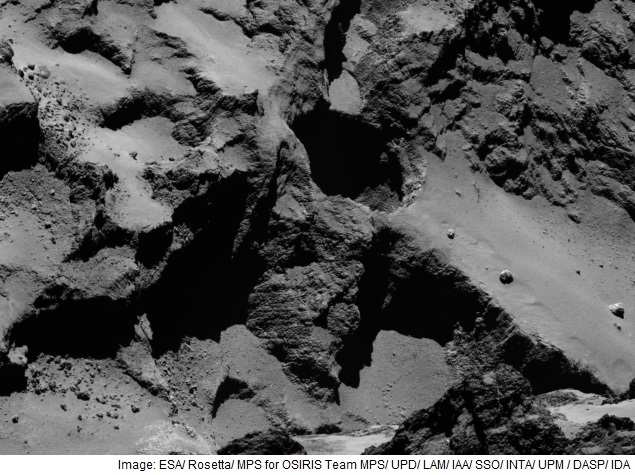- Home
- Science
- Science News
- Rosetta Spacecraft Finds Massive Sinkholes on Comet's Surface
Rosetta Spacecraft Finds Massive Sinkholes on Comet's Surface

Scientists suspect the pits formed when material on the comet's surface collapsed, similar to sinkholes on Earth, a study published in the journal Nature said.
The cavities on comet 67P/Churyumov-Gerasimenko, which Rosetta has been orbiting since August, are enormous, stretching some 656 feet (200 meters) in diameter and 590 feet (180 meters) in depth.
In comparison, the Great Pyramid is 756 feet (230 meters) across and currently 455 feet (139 meters) tall.
The discovery is expected to help scientists piece together a better understanding of how comets formed and evolved.
"Finding the pits was a total surprise," said space physicist Paul Weissman, with Nasa's Jet Propulsion Laboratory in California.
Comets like 67P are believed to be rubble piles of boulder-sized mini-comets made of rock, organics and ices. Gravity pins them together gently, with lots of open spaces in what eventually forms the comet's body.
Why the pits begin collapsing is not yet known, but could be related to the heating a comet experiences as it travels closer to the sun. Several of 67P's sinkholes, for examples, are pumping out jets of dust.
"We see jets arising from the fractured areas of the walls inside the pits. These fractures mean that volatiles trapped under the surface can be warmed more easily and subsequently escape into space," lead researcher Jean-Baptiste Vincent, with the Max Planck Institute for Solar System Research, said in a statement.
Similar circular shapes have been found on the surface of other comets, but those pits were filled in by new material that had collected over the eons. Scientists suspect they are seeing freshly formed pits on 67P, which in August will reach its closest point to the sun in its 6.5-year orbit.
None of the 18 pits found on the surface of 67P are located near where Europe's Philae lander settled in November. Scientists are attempting to re-establish a steady communications link between the newly revived Philae and Rosetta so the lander can resume science operations.
The European Space Agency last week extended Rosetta's mission, which was due to end in December, to September 2016.
© Thomson Reuters 2015
Catch the latest from the Consumer Electronics Show on Gadgets 360, at our CES 2026 hub.
Related Stories
- Samsung Galaxy Unpacked 2025
- ChatGPT
- Redmi Note 14 Pro+
- iPhone 16
- Apple Vision Pro
- Oneplus 12
- OnePlus Nord CE 3 Lite 5G
- iPhone 13
- Xiaomi 14 Pro
- Oppo Find N3
- Tecno Spark Go (2023)
- Realme V30
- Best Phones Under 25000
- Samsung Galaxy S24 Series
- Cryptocurrency
- iQoo 12
- Samsung Galaxy S24 Ultra
- Giottus
- Samsung Galaxy Z Flip 5
- Apple 'Scary Fast'
- Housefull 5
- GoPro Hero 12 Black Review
- Invincible Season 2
- JioGlass
- HD Ready TV
- Laptop Under 50000
- Smartwatch Under 10000
- Latest Mobile Phones
- Compare Phones
- Honor Magic 8 RSR Porsche Design
- Honor Magic 8 Pro Air
- Infinix Note Edge
- Lava Blaze Duo 3
- Tecno Spark Go 3
- iQOO Z11 Turbo
- OPPO A6c
- Samsung Galaxy A07 5G
- Lenovo Yoga Slim 7x (2025)
- Lenovo Yoga Slim 7a
- Lenovo Idea Tab Plus
- Realme Pad 3
- Moto Watch
- Garmin Quatix 8 Pro
- Haier H5E Series
- Acerpure Nitro Z Series 100-inch QLED TV
- Asus ROG Ally
- Nintendo Switch Lite
- Haier 1.6 Ton 5 Star Inverter Split AC (HSU19G-MZAID5BN-INV)
- Haier 1.6 Ton 5 Star Inverter Split AC (HSU19G-MZAIM5BN-INV)







![[Sponsored] Haier C90 OLED TV | Dolby Vision IQ, 144Hz OLED and Google TV in Action](https://www.gadgets360.com/static/mobile/images/spacer.png)









